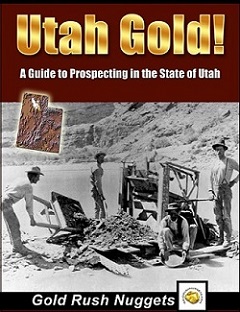
In the 19th Century, while other western states played the perfect hosts to miners, Utah had nothing much to offer. Utah wasn’t devoid of gold, but compared to others, it didn’t provide many opportunities to gold prospectors.
Surprisingly, a century-and-a-half later, Utah finds itself in the list of the top gold producing states. Much of its gold is a byproduct of copper, zinc, lead, and silver mining. The Bingham Canyon Mine (later became the Kennecott Copper Mine) is the largest producer of gold in the state.
History of the Bingham Canyon Mine in Utah
The Bingham Canyon is the largest open-pit mine in the world. It’s located in the Oquirrh Mountains. At present, a multinational company is operating the copper mine near Salt Lake City.
The mine gets its name from the Sanford and Thomas Brothers, who first discovered copper in the area. Heeding to the advice from their Mormon leader, the two brothers relinquished claim over the canyon. In 1863, West Jordan, followed by Vidette, claimed their right over the canyon.
At first, the miners showed interest only in extracting precious metals such as gold and silver. It was only after the construction of the railroad in 1873 that copper and minerals found favor with the miners.
In 1896, Thomas Weir and Samuel Newhouse established the Kennecott Copper Mine and also bought the Highland Boy Gold Mines, known for their rich copper and gold deposits. Later, in 1903, the Utah Copper Company came into existence. It was founded by Enos Wall and Daniel Jackling. Three years later, the company began operations in the same area.
The Open-Pit Expands
Both companies opted for the open-pit mining method because of the low-grade, large volume of copper in the area. Instead of competing with each other, both companies decided to merge in 1907. As a result of the merger, the operations expanded and within 5 years it became the largest mine in the world.
In the next two decades, the mine changed hands, yet continued to expand rapidly. At one point, the company employed thousands of people. In the 1930s, technological advancements led to layoffs. This continued for several decades, until the 1980s when the company had just 800 people on its payroll.
In 1985, increasing costs forced the closure of the company for a brief period. The operations began as soon as the company discovered gold in the neighboring Barney’s Canyon. Again the Kennecott Copper Mine changed hands and a UK-Australian company is the current owner of the mine. The Rio Tinto Group brought sweeping changes, cut costs, and restored the company to profitability. In 2013, two major landslides temporarily shut down the operations in the mine.
The company is currently planning on adding another 1000 feet depth to prolong the operations of the mine until the 2030s. The Kennecott Copper Mine (formerly the Bingham Canyon Mine) is the largest copper and gold producing mine in the state.
Finding Gold in the Rivers and Creeks of Utah
In the 19th century, there were thousands of men throughout the West checking every creek and river for gold. Even Mark Twain had a go at it, with little success.
The state of Utah wasn’t the favorite of many prospectors. Most placer deposits had very little gold and the precious metal discovered was fine dust; of not the best quality.
Utah is rich in other minerals, but in those days not many miners had money to use cyanide leaching methods to extract minerals. Gold prospectors had to shift their focus to rivers and creeks that still carried a sufficient amount of gold. Time was better spent in neighboring states like Arizona and Nevada.
The fine gold dust is hard to mine. To separate the fine gold from the dirt, the miners must pass material through a sluice box. But, it Utah, there isn’t enough water to adopt such a method to extract fine gold.
In Utah, many mines that extract minerals and base metals produce gold as a byproduct. The rivers and creeks close to these mines are potential areas to pan gold. But, not many have had luck finding gold in significant concentrations.
That said; gold prospectors looking to explore the vast lands of Utah can start at the following places. These areas have documented placer gold deposits.
The Green River, in the northeast, and the San Juan River, in the southwest, contain fine placer gold. The creeks that drain the Oquirrh Mountains, near the Bingham Mine and the Henry Mountains contain fine gold. Similarly, the creeks in the Abajo Mountains – Recapture and Johnson Creeks – have placer gold.
Last on the list is the Colorado River. The gold here is extremely fine and quite difficult to recover. A prospector can make a fortune from the gold collected here, but a great deal of effort and extreme care are prerequisites to amass enough gold to make a sufficient amount of money.

